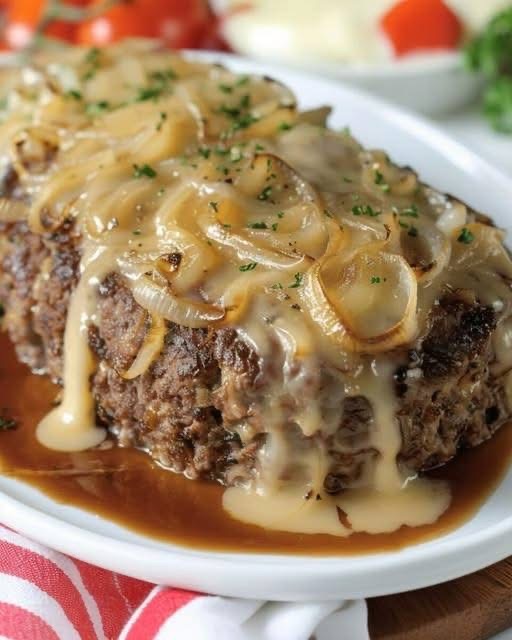
Ingredients
For the Meatloaf:
- 2 lbs (900 g) ground beef (80/20 blend for juiciness)
- 1 cup breadcrumbs (plain or seasoned)
- 1/2 cup whole milk
- 2 large eggs
- 1 medium onion, finely chopped
- 3 cloves garlic, minced
- 1/2 cup parsley, chopped (optional)
- 2 tbsp Worcestershire sauce
- 2 tbsp ketchup
- 1 tsp Dijon mustard
- 1 tsp smoked paprika (optional)
- 1 1/2 tsp salt
- 1 tsp black pepper
For the Onion Gravy:
- 2 tbsp butter
- 2 large onions, thinly sliced
- 2 tbsp flour
- 2 cups beef broth (or stock)
- 1 tsp Worcestershire sauce
- 1/2 tsp garlic powder
- Salt & pepper, to taste
Instructions
Step 1 – Prepare the Meatloaf Mixture
- In a bowl, combine the breadcrumbs and milk; let soak for 5 minutes to soften.
- Add eggs, onion, garlic, parsley, Worcestershire sauce, ketchup, mustard, paprika, salt, and pepper. Mix well.
- Add ground beef and mix gently with your hands until just combined (do not overmix, or the loaf will be dense).
Step 2 – Shape and Bake
- Preheat oven to 375°F (190°C).
- Shape the meat mixture into a loaf on a lined baking sheet or loaf pan.
- Bake uncovered for 50–60 minutes, or until internal temperature reaches 160°F (70°C).
- Remove from oven and let rest 10 minutes before slicing.
Step 3 – Make the Onion Gravy
- In a skillet, melt butter over medium heat.
- Add sliced onions and cook until golden and caramelized (about 10–12 minutes).
- Sprinkle flour over onions, stir well, and cook for 1–2 minutes.
- Slowly whisk in beef broth and Worcestershire sauce until smooth.
- Simmer until thickened (5–7 minutes). Season with garlic powder, salt, and pepper.
Step 4 – Serve
- Place the meatloaf on a platter.
- Pour onion gravy over the top.
- Garnish with parsley.
🍽️ Serving Suggestions
- Mashed potatoes or creamy polenta
- Steamed green beans or roasted vegetables
- Fresh garden salad
Benefits
- High protein meal that’s satisfying and filling.
- Comfort food that’s budget-friendly.
- Leftovers taste even better the next day.
History of Meatloaf
Ancient Roots
- The idea of mixing ground meat with other ingredients to stretch it further is very old.
- In Ancient Rome (around 5th century AD), there are records in Apicius (a Roman cookbook) of ground meat mixed with bread, wine, and seasonings, shaped into loaves.
German & European Influence
- Meatloaf as we know it traces its European heritage, especially in Germany, Belgium, and Scandinavia.
- In Germany, a similar dish called Falscher Hase (“false hare”) dates back to the 18th century. It was shaped like a hare and often served with gravy and boiled potatoes.
- In the 19th century, Germans and other European immigrants brought these recipes to America.
Meatloaf in America
- By the late 1800s, cookbooks in the U.S. included recipes for meatloaf.
- It became especially popular in the Great Depression (1930s), because families could stretch a small amount of meat with breadcrumbs, oatmeal, or other fillers.
- After World War II, meatloaf was a staple of American home cooking—served with ketchup or tomato glaze, or with onion gravy like in your photo.
Onion Gravy Style
- The gravy-topped meatloaf likely evolved from German “Falscher Hase” and French-inspired gravies, combining caramelized onions with a roux-based sauce.
- It became a diner favorite in mid-20th-century America, especially as a “comfort food” served with mashed potatoes.
Modern Popularity
USA → Classic glazed or onion-gravy versions.
Today, meatloaf has global variations:
Italy → Polpettone (stuffed meatloaf, sometimes with eggs or cheese inside).
Philippines → Embutido (steamed meatloaf with sausage and vegetables).
Middle East → Kafta (ground meat with spices, sometimes loaf-shaped).